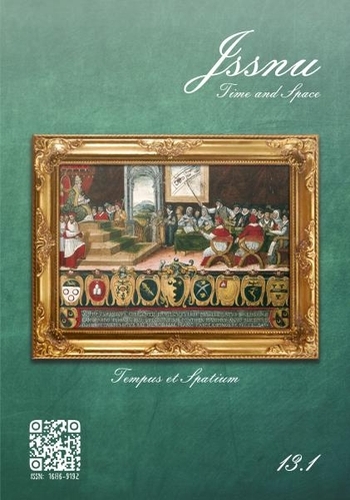The Creation of New Culture and the Historical Plays of Luang Wijitwatakarn: The Structure of Feeling and Militarist Nationalist Memory under the People’s Party Military Wing
Main Article Content
Abstract
This article argues that under the process of modernization during the reign of King Chulalongkorn and the period of emergent capitalism, there arose a new structure of feeling in Thailand: the feeling that birth and status are not the measure of man, and that lead to the changes or a “revolution” in socio-political structures and relations that in turn gave rise to the “democracy” established by the People’s Party (Khana Rajsadon). This structure of feeling continues to adapt itself from generation to generation in relation to the ongoing process of modernization, while also coexisting alongside the old structure of feeling that has not faded away. This research looks at the creation of a new culture through “Statism” (Rataniyom) and the historical plays composed by Luang Wijitwatakarn and popularized through dramatic production. Both “Statism” and the plays exist as cultural or artistic artifacts, representing and forging the common feelings and experiences of members of the military wing of the People’s Party into a shared understanding and reality, and which reveals itself through concrete political structures and the organization of social relations along military lines. At the same time, this militarist structure of feeling existed alongside and intermingled with the structure of feelings of the mid-level bureaucrats and the intellectual middle class identified with democracy. The military wing therefore preserved the political structure of the People’s Party: the constitution, a parliament, and government elected by parliament, but which are coupled to leadership by the military strongman and the organization of social relations itself along military lines. With succeeding generations, these structures have changed and will continue to transform, forming part of the long and unfinished revolution.
Downloads
Article Details
References
เกรียงศักดิ์ เชษฐพัฒนวนิช. (2536). แนวความคิดประชาธิปไตยแบบไทย. วิทยานิพนธ์รัฐศาสตร์มหาบัณฑิต คณะรัฐศาสตร์ มหาวิทยาลัยธรรมศาสตร์
คริส เบเกอร์ และผาสุก พงษ์ไพจิตร. (2558). ประวัติศาสตร์ไทยร่วมสมัย. กรุงเทพ: มติชน
ชาญวิทย์ เกษตรศิริ. (2549). ประวัติการเมืองไทย 2475-2500. กรุงเทพ: มูลนิธิโครงการตำราสังคมศาสตร์และมนุษยศาสตร์
นครินทร์ เมฆไตรรัตน์. (2553). ปฏิวัติสยาม พ.ศ. 2475. กรุงเทพ: ฟ้าเดียวกัน
ประอรรัตน์ บูรณมาตร์. (2528). บทละครประวัติศาสตร์ของหลวงวิจิตรวาทการ. กรุงเทพ: สำนักพิมพ์มหาวิทยาลัยธรรมศาสตร์ และ มูลนิธิโครงการตำราสังคมศาสตร์และมนุษยศาสตร์
ฤดีชนก รพิพันธุ์. (2546). ละครหลวงวิจิตร. วิทยานิพนธ์ศิลปศาสตรมหาบัณฑิต (นาฏยศิลป์ไทย) คณะศิลปกรรมศาสตร์ จุฬาลงกรณ์มหาวิทยาลัย
สมศักดิ์ เจียมธีรสกุล. (2544). ประวัติศาสตร์ที่เพิ่งสร้าง. กรุงเทพ: สำนักพิมพ์ 6 ตุลารำลึก.
สายชล สัตยานุรักษ์. (2557). 10 ปัญญาชนสยาม เล่ม 2. กรุงเทพ: สำนักพิมพ์ openbooks
อรรถจักร์ สัตยานุรักษ์. (2555). การเปลี่ยนแปลงโลกทัศน์ของชนชั้นนำไทย
ตั้งแต่รัชกาลที่ 5 ถึง พ.ศ. 2475. (พิมพ์ครั้งที่ 3). กรุงเทพ: สำนักพิมพ์จุฬาลงกรณ์มหาวิทยาลัย.
เอกสารภาษาต่างประเทศ
Connerton, Pual. (1955). How Society Remember. Cambridge: Cambridge University Press.
Cris Baker and Pasuk Phongpaichit, (2014). A History of Thailand. (Third edition). Cambridge: Cambridge University Press.
Halbwachs, Maurice. (1992). On Collective Memory. Chicago: The University of Chicago Press.
Longhurst, Brian et al.(2005). Introducing Cultural Studies. Peking: Pearson Education Asia Limited and Peking University Press.
natalierosebradbury. (2013). Raymond Williams on art and society. Retrieved from https://picturesforschools.wordpress.com/2013/10/23/raymond-williams-on-art-and-society/
William, Raymond. (1965). The Long Revolution. London: Pelican Books.
……………………………. (1983). Keywords: A Vocabulary of Culture and Society. London: Fontana.
Translated Thai References
Baker, C. and Phongpaichit, P. (2015). Contemporary History of Thailand. Bangkok: Matichon Press.
Buranamaat, P. (1984). Historical Plays of Luang Wijitwatakarn. Bangkok: The Foundation for the Promotion of Social Sciences and Humanities Textbooks Project.
Chetpatanavanich, K. (1993). Conceptions of Thai Democracy. Master’s Thesis in Political Sciences, Faculty of Political Sciences, Thammasat University.
Jeamthiraskul, S. (2002). Newly Constructed History. Bangkok: 6 Tula Recall Press.
Kasetsiri, C. (2006). The History of Thai Politics 1932-1957. Bangkok: The Foundation for the Promotion of Social Sciences and Humanities Textbooks Project.
Mektrairat, N. (2010). 1932 Siamese Revolution. Bangkok: Fa Diao Kan.
Raphipan, R. (2003). Luang Wijit’s Plays. Master’s Thesis in Arts (Thai Dance), Faculty of Fine and Applied Arts, Chulalongkorn University.
Sattayanurak, A. (2012). The Transformation of Thai Elites’ World View from Rama V to 1932. Bangkok: Chulalongkorn University Press.
Sattayanurak, S. (2014). 10 Siamese Intellectuals vol. 2. Bangkok: openbooks Press.


